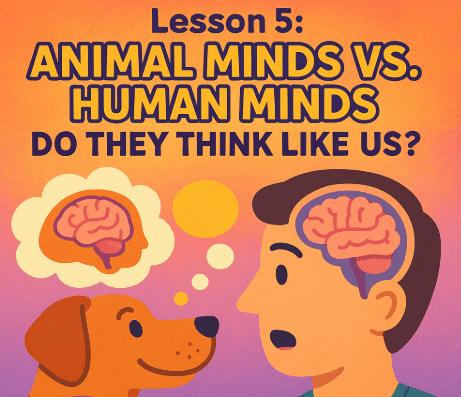
In Lesson 4, we explored why intelligence evolved. We learned that while big brains are expensive, they brought survival benefits: better food strategies, stronger social bonds, flexibility in changing environments, and even attracting mates. The key superpower of intelligence was learning and adaptability.
Now, we ask: Are humans truly the only intelligent creatures, or do other animals also “think” like us?
The Myth of “Dumb Animals” 🐑❌
For centuries, people believed animals were just instinct-driven machines, with no real thought or feelings. Descartes, a famous philosopher, once said animals were like “biological robots.”
But modern science has overturned this idea. Many animals show intelligence—sometimes in surprising, even human-like ways. Let’s look at some of the champions of the animal kingdom.
Dolphins: The Ocean Thinkers 🐬


Dolphins have brains that are almost as large as humans, and their encephalization quotient (EQ) is among the highest in the animal world.
What dolphins can do:
-
Use complex communication, with clicks and whistles that might function like names.
-
Recognize themselves in mirrors (a sign of self-awareness).
-
Work together to herd fish, even coordinating with humans in some parts of the world.
-
Play games for fun—showing imagination and joy.
Dolphins demonstrate that intelligence isn’t limited to land mammals.
Elephants: Memory and Empathy 🐘
Elephants have brains larger than any land animal. They’re famous for their memory, but their intelligence goes even deeper.
What elephants can do:
-
Recognize themselves in mirrors (like dolphins and humans).
-
Remember water holes and migration routes for decades.
-
Mourn their dead—standing by the bones of relatives in silence.
-
Use tools, such as branches, to swat flies.
Elephants show not just memory, but also empathy—the ability to feel and respond to the emotions of others.
Crows and Ravens: Feathered Geniuses 🐦

You don’t need a big mammal brain to be smart. Crows and ravens, members of the crow family (corvids), have tiny brains—but packed with neurons in clever arrangements.
What crows can do:
-
Use and even make tools—like bending a wire into a hook to get food.
-
Recognize human faces and remember them for years.
-
Plan ahead, saving food for the future.
-
Solve puzzles that require multiple steps, like “If I drop a stone into this tube, water rises, and then I can get the food.”
Crows are proof that intelligence doesn’t depend only on brain size—it depends on how brains are wired.
Great Apes: Our Closest Cousins 🦍
Chimpanzees, bonobos, orangutans, and gorillas are our evolutionary siblings. Their intelligence overlaps with ours in many ways.
They can:
-
Use sticks to fish termites or crack nuts with stones.
-
Teach skills to younger members of the group.
-
Show emotions like jealousy, grief, or kindness.
-
Learn sign language or symbols to communicate with humans.
For example, a gorilla named Koko learned over 1,000 signs in American Sign Language and could express emotions like love and sadness.
What Makes Humans Different? 🤔
If animals can think, feel, and use tools, what makes us unique? Scientists suggest a few key differences:
-
Language: Animals communicate, but only humans have complex grammar, allowing us to tell stories, teach abstract ideas, and record history.
-
Cumulative Culture: Humans build on the knowledge of previous generations. A crow might invent a tool, but it doesn’t write down instructions for future crows. Humans pass knowledge across centuries.
-
Imagination: We can imagine things that don’t exist yet—like airplanes before they were invented.
-
Large-scale cooperation: Humans can work together in groups of millions, not just families or small tribes, thanks to shared stories, rules, and beliefs.
So while animals share many elements of intelligence with us, humans combined these abilities in unique ways that transformed the planet.
The Human and the Crow 🌍
Imagine an ancient human child and a crow both facing the same problem: a jar with food at the bottom, too deep to reach.
-
The crow thinks: “What if I drop stones into the jar?” It does, and the water rises. The crow gets the food.
-
The human child thinks: “What if I use a stick as a spoon?” They do, and they get the food too.
Both solved the problem with tools. But the difference? The human goes home and tells the story, teaches the trick, and one day writes it down. A thousand years later, humans are building machines. The crow keeps solving the jar problem—but never invents a factory.
This shows how human intelligence is not just about solving problems—it’s about passing knowledge forward.
Key Takeaways 🌟
-
Many animals show remarkable intelligence: dolphins, elephants, crows, and apes all think and feel in advanced ways.
-
Human uniqueness lies in language, cumulative culture, imagination, and cooperation.
-
Intelligence is not all-or-nothing. It exists on a spectrum across the animal kingdom.
-
Studying animal minds teaches us humility—and shows us how intelligence evolved step by step, not in one sudden leap.